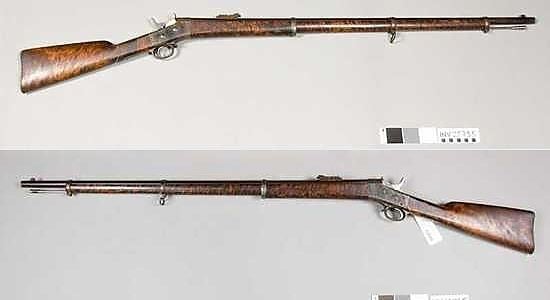In service 1867–1918 | Designed 1864 | |
 | ||
Wars American Indian Wars, Franco-Prussian War, Russo-Turkish War, War of the Pacific, Philippine Revolution, Philippine-American War, Mexican Revolution, World War I, Italo-Turkish War | ||
The Remington Rolling Block rifle was a breech-loading rifle produced from the mid-1860s into the early 20th century by E. Remington and Sons (later Remington Arms Company). The action was extremely strong, and could easily withstand the increased pressure of the new smokeless powders coming into use by the late 1880s.
Contents
It was made in a variety of calibers, both rimfire and centerfire, including the 12.17x42 mm rimfire, 12.17x44 mm rimfire and 12.17x44 mm rimmed centerfire Swedish and Norwegian cartridges, .43 Spanish (11.15x58mmR), .50-70, 40-70.45-70, and later in .22 caliber. Later models were produced in .30-06 Springfield, 7×57mm Mauser, and 8×50mmR Lebel.
Service rifle
In 12.17x42mmRF and 12.18x44mmRF (two cartridges that were interchangeable), and towards the end of its service life also 8x58mmR Danish Krag centerfire, it served as the standard service rifle of the Swedish Army from 1867 to the mid-1890s (when it was replaced by the Swedish Mauser) and in Norway as the standard service rifle from 1867 to the mid-1880s (when it was replaced by the M1884 Jarmann). In .43 Spanish it was the chief service arm of the Spanish Army from 1870–1893, and was used by reserve and militia forces for many years thereafter. Many Rolling Block rifles were used by Argentina before being replaced in 1891 by the new 7.65mm Mauser, and were also widely used by Egypt and Mexico. The Remington rolling block also became the standard service rifle of the Danish Army. During the Franco-Prussian War, France acquired 210,000 Rolling Block rifles to make up for a shortage of the standard-issue Chassepot.
Sweden and Norway (at that time in a union, the United Kingdoms of Sweden and Norway) adopted the rifle in 1867, being among the very first nations to adopt the Remington rolling block as their standard military rifle, and large numbers of Remington rolling block rifles and carbines were produced under license in Sweden and Norway. Around 250,000 military rifles and carbines and 85,000 civilian rifles in Sweden, were produced by Carl Gustafs Stads Gevärsfaktori (a government arsenal) and Husqvarna Vapenfabriks Aktiebolag, and about 53,000 military rifles in Norway by Kongsberg Vaapenfabrik.
During World War I, the British Royal Navy purchased 4,500 Rolling Block rifles in 7mm Mauser from Remington's leftover stock after production had ended, issuing them to the crews of minesweepers and Q-ships. In November 1914, production of the Rolling Block was resumed, in the form of a French contract for rifles in 8×50mmR Lebel, designated by France as "Fusil Remington modèle 1914". 100,291 such rifles were delivered by 1916, and used to equip rear-line troops.
Civilian use
Along with the Sharps rifle it was one of two rifles probably used more than any other by the buffalo hunters who hunted the American bison herds in the 1870s and 1880s.
Civilian Remington rolling block rifles, and later surplus military rifles, became very popular among hunters in Scandinavia, particularly for moose hunting, with ammunition for the rifles being commonly available on the civilian market into the 1920s-1930s.
